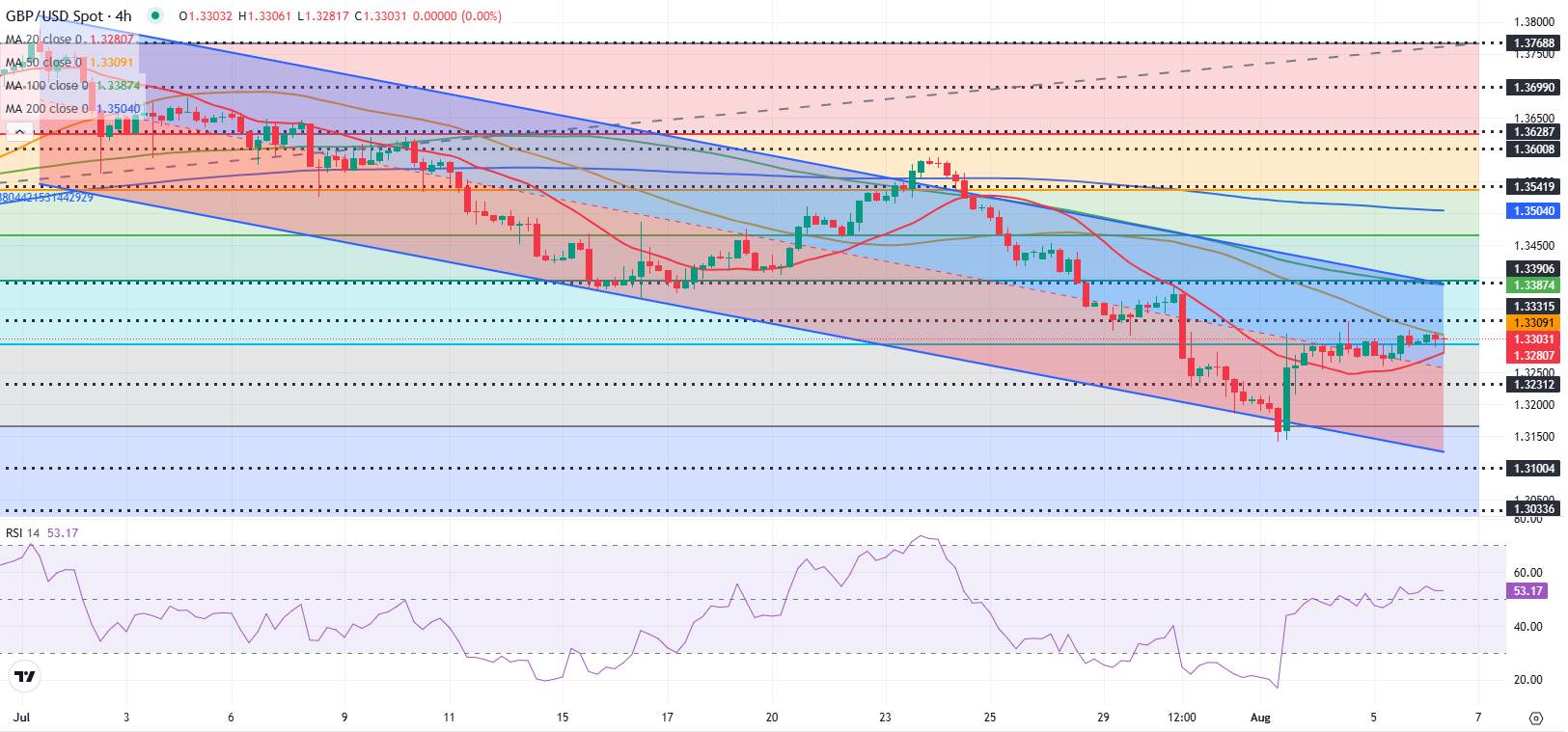- GBP/USD continues to fluctuate in a narrow band at around 1.3300.
- The Bank of England (BoE) is expected to cut policy rate by 25 bps on Thursday.
- The pair’s technical outlook points to a neutral stance in the near term.
After posting marginal gains on Tuesday, GBP/USD extends its sideways grind at around 1.3300 midweek. Investors could refrain from taking large positions ahead of the Bank of England’s (BoE) monetary policy announcements on Thursday.
British Pound PRICE Last 7 days
The table below shows the percentage change of British Pound (GBP) against listed major currencies last 7 days. British Pound was the weakest against the Japanese Yen.
| USD | EUR | GBP | JPY | CAD | AUD | NZD | CHF | |
|---|---|---|---|---|---|---|---|---|
| USD | -0.42% | 0.35% | -0.40% | -0.04% | 0.29% | 0.53% | 0.20% | |
| EUR | 0.42% | 0.80% | -0.03% | 0.35% | 0.67% | 0.96% | 0.66% | |
| GBP | -0.35% | -0.80% | -0.83% | -0.39% | -0.10% | 0.19% | -0.12% | |
| JPY | 0.40% | 0.03% | 0.83% | 0.44% | 0.76% | 1.01% | 0.65% | |
| CAD | 0.04% | -0.35% | 0.39% | -0.44% | 0.33% | 0.57% | 0.27% | |
| AUD | -0.29% | -0.67% | 0.10% | -0.76% | -0.33% | 0.29% | -0.00% | |
| NZD | -0.53% | -0.96% | -0.19% | -1.01% | -0.57% | -0.29% | -0.29% | |
| CHF | -0.20% | -0.66% | 0.12% | -0.65% | -0.27% | 0.00% | 0.29% |
The heat map shows percentage changes of major currencies against each other. The base currency is picked from the left column, while the quote currency is picked from the top row. For example, if you pick the British Pound from the left column and move along the horizontal line to the US Dollar, the percentage change displayed in the box will represent GBP (base)/USD (quote).
The US Dollar (USD) managed to stay resilient against its rivals as the Institute for Supply Management’s (ISM) mixed Services Purchasing Managers’ Index (PMI) report failed to trigger a noticeable reaction.
The headline ISM Services PMI edged lower to 50.1 in July from 50.8 in June, pointing to a loss of growth momentum in the US service sector’s economic activity. The Employment Index of the survey declined to 46.4 from 47.2 in this period, highlighting a further contraction in the sector’s payrolls. Finally, the Prices Paid Index, the inflation component, climbed to 69.9 from 67.5.
The BoE is widely anticipated to cut the policy rate by 25 basis points (bps) to 4% following the August meeting. Markets expect seven members of the Monetary Policy Committee (MP) to vote in favor of this decision, against two votes to keep the rates unchanged.
Previewing the BoE meeting, “focus will be on the vote split with markets expecting a quarterly pace of cuts. Any unexpected dovish lean on the back of recent softness in data can weigh on the GBP,” said TD Securities analysts.
Ahead of the BoE event, several Federal Reserve (Fed) policymakers will be delivering speeches in the American session on Wednesday. According to the CME FedWatch Tool, markets are currently pricing in a nearly-90% probability of a 25 basis points Fed rate cut in September. Hence, any comments hinting at a September rate reduction could be ignored by markets. On the other hand, the USD could gather strength and make it difficult for GBP/USD to gain traction in the near term in case Fed officials downplay the weak labor market data and reiterate the need for patience.
GBP/USD Technical Analysis

The Relative Strength Index (RSI) indicator on the 4-hour chart stays flat near and GBP/USD trades between the 20-period and the 50-period Simple Moving Averages (SMAs), reaffirming the neutral bias.
On the downside, 1.3250 (mid-point of the descending channel) aligns as the first support level ahead of 1.3200 (static level, round level) and 1.3130 (lower limit of the descending channel).
Looking north, immediate resistance could be spotted at 1.3300 (static level, round level, 50-period SMA) before 1.3330 (former support level, static level) and 1.3390-1.3400 (100-period SMA, upper limit of the ascending channel).
Pound Sterling FAQs
The Pound Sterling (GBP) is the oldest currency in the world (886 AD) and the official currency of the United Kingdom. It is the fourth most traded unit for foreign exchange (FX) in the world, accounting for 12% of all transactions, averaging $630 billion a day, according to 2022 data.
Its key trading pairs are GBP/USD, also known as ‘Cable’, which accounts for 11% of FX, GBP/JPY, or the ‘Dragon’ as it is known by traders (3%), and EUR/GBP (2%). The Pound Sterling is issued by the Bank of England (BoE).
The single most important factor influencing the value of the Pound Sterling is monetary policy decided by the Bank of England. The BoE bases its decisions on whether it has achieved its primary goal of “price stability” – a steady inflation rate of around 2%. Its primary tool for achieving this is the adjustment of interest rates.
When inflation is too high, the BoE will try to rein it in by raising interest rates, making it more expensive for people and businesses to access credit. This is generally positive for GBP, as higher interest rates make the UK a more attractive place for global investors to park their money.
When inflation falls too low it is a sign economic growth is slowing. In this scenario, the BoE will consider lowering interest rates to cheapen credit so businesses will borrow more to invest in growth-generating projects.
Data releases gauge the health of the economy and can impact the value of the Pound Sterling. Indicators such as GDP, Manufacturing and Services PMIs, and employment can all influence the direction of the GBP.
A strong economy is good for Sterling. Not only does it attract more foreign investment but it may encourage the BoE to put up interest rates, which will directly strengthen GBP. Otherwise, if economic data is weak, the Pound Sterling is likely to fall.
Another significant data release for the Pound Sterling is the Trade Balance. This indicator measures the difference between what a country earns from its exports and what it spends on imports over a given period.
If a country produces highly sought-after exports, its currency will benefit purely from the extra demand created from foreign buyers seeking to purchase these goods. Therefore, a positive net Trade Balance strengthens a currency and vice versa for a negative balance.







